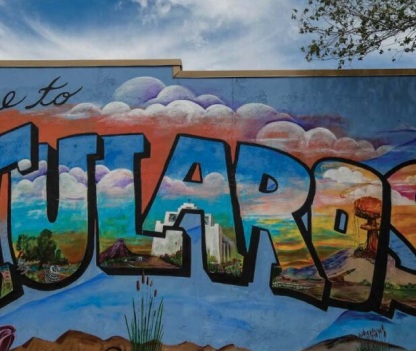Agricultural Oasis in the Desert
November 18, 2023 | Visit Alamogordo | Original Article
Tularosa is a charming, small community, approximately 14 miles north of Alamogordo on US-54. Named after the rose-colored reeds and red cattail lining the Rio Tularosa, the location was chosen based on a reliable source of water in an otherwise arid region.
Repeated flooding on the Rio Grande around Las Cruces, Doña Ana, and La Mesilla prompted a small group of farmers to venture north, deep into Apache territory, to establish a settlement on the Rio Tularosa in 1858. The Apache were not receptive to new neighbors, ejecting the settlers within a month. A second group tried again three years later, with similar results. However, the prospect of fertile farmland in a drought prone environment inspired a third group of farmers to try again in 1862.
Unlike their predecessors, the third round of settlers survived the growing season, harvesting their first crops in 1862. The village of Tularosa was formally established in 1863, parsed into 49 blocks, with water rights distributed equitably. The founders dug a network of ditches (acequias) to provide irrigation, a system that continues to feed the tree-lined streets, landscaping, and private gardens in Tularosa’s historic district. The National Register of Historic Places added the townsite in 1979, including the original 1400-acres and 182 buildings
The village grew with each successful harvest. Farmers started moving their wives and children to the area, drawing the ire of the Mescalero Apache, who were being pushed off their land during the 1860s by waves of prospectors and settlers. Conflict was brewing; however, the citizens of Tularosa anticipated an attack, soliciting support from the soldiers at nearby Fort Stanton.
Battle of Round Hill
The inevitable conflict occurred near Round Hill, approximately 10-miles east of Tularosa. Round Hill isn’t a prominent hill, rising a mere 300-feet above the surrounding plains; however, it provided a defensible position, allowing the soldiers and townsfolk to prevail against a large group of Apache warriors. There are numerous versions of the battle, with key commonalities that are accepted as fact. For example, the victory was based on a collaboration between men from Tularosa and soldiers from Fort Stanton.
In one version, a group of five cavalrymen were ambushed while patrolling a wagon route outside of Tularosa. The soldiers managed to escape to Tularosa, recruiting twenty-six men from the village to confront the Apache the following day
In another version, soldiers from Fort Stanton were escorting a supply wagon to Fort Selden when they were attacked, withdrawing to an adobe structure on Round Hill to return fire. After several hours, the group of twenty-six villagers barreled into the battle at full gallop, with guns blazing. The second version sounds more dramatic, like a scene out of a western. Regardless, several Apache warriors were killed during the 6-hour showdown. None of Tularosa’s defenders perished.
During the battle, the remaining residents of Tularosa gathered to pray around a picture of St. Francis de Paula, a talisman brought to Tularosa from La Mesilla in 1862. When the men returned to town victorious, their unlikely victory was attributed to divine intervention. Today, the Battle of Round Hill is commemorated annually during the Saint Francis de Paula Fiesta.
Saint Francis de Paula Church
The battle of Round Hill was a turning point. The following year, in 1869, a peace treaty was established between the United States and the Mescalero Apache, facilitating the growth and development of communities throughout the Tularosa Basin and Sacramento Mountains. In Tularosa, the villagers fulfilled a promise made to St. Francis de Paula during the battle. They started building a church in his honor in 1868. Villagers based the design on the Spanish mission churches around Mesilla, using over 50,000 adobe bricks. The Rev. Francis Boucard presided over the first mass in May of 1869. The current church incorporates the original, but it has been expanded and renovated over the years. The current structure is about twice as big as the original.
St Francis De Paula Parish
704 St Francis Dr
Tularosa, NM 88352
(575) 585-2793
Village of Tularosa
705 St. Francis Drive
Tularosa, NM 88352
(575) 585-2771
Direction
Tularosa is located at the base of the Sacramento Mountains. Located at the junction of New Mexico highways 54 and 70, Tularosa is the gateway to Ruidoso and the Mescalero Indian reservation.





